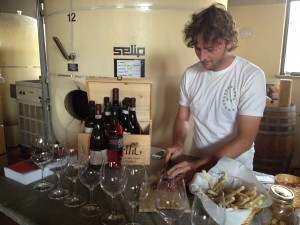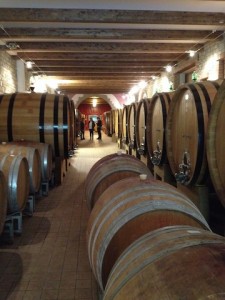Despite all my heroic efforts to reduce the volume of wine in my cantina, admirably assisted by family and friends, I am failing miserably. This is entirely due to the excellent quality/value of the hundreds of producers on my doorstep. I seldom go for a tasting with the intention of buying but somehow a few bottles always seem to find their way into the back of the car. The most recent examples are Stella, Vigne dei Mastri, Ca del Baio, and Fratelli Alessandria
So what couldn’t I resist that has sneaked its way back home:
Fratelli Alessandria is a family business originating from the end of the 18c and Vittore represents the 5th generation. It is the first cantina I have visited in the commune of Verduno which is responsible for around 5% of the total 12 million bottles of Barolo produced.
The “Monvigliero” 2008 Barolo (6k) is from an important local cru which has 10 producers, a soil that has more clay and vines that are 35 years old. Traditionally made with 2 years in botti grandi after 6 months in tonneau producing more elegance than muscle. The Langhe Nebbiolo 2011 2011 immediately took my attention. 6 months in bottle, 8 months in botti. Chilli jam nose, fresh cherries just how I like it for an everyday nebbiolo fix! I was tempted by the unique Pelaverga 2012, A grape native to Verduno. A mouthful and nose of ground black pepper and if I hadn’t like the other 2 wines so much I would have taken a few bottles but I can also go back.
Vigne dei Mastri is totally committed to eco-friendly production with zero CO2 emissions as a result of its use of solar panels, rain water collection. and other energy saving methods. Our knowledgeable and charming host Ermando is a young Robert Plant look-alike! I am not always a fan of grape mixes as I love the pure local varieties rather than some the attempts to tap international markets, but, I found myself persuaded to the contrary. The inexpensive “Chiara” is a perfect, clean,crisp, citrus aperitivo made from 60% Riesling and 40% Pinot Bianco. The Rodatà 2010 (50% Barbera/50% Merlot)is now regularly opened at our house as a straightforward alternative to Dolcetto but with less fruit. Light smooth tannins.and a decent rounded structure as a result of 6 months in French tonneau. The “Marcello” 2010 is a similar blend and oozes fruit and spice and longer ageing (18 months) in tonneau provides a decent balanced length. Both are a refreshing alternative to the ubiquitous Merlot varietals. There is also a classic Barbera “Arturo” and an experimental late harvest (November) “Super Ba” that has hints of sweet caramel and fruit drops and smooth length.
Stella‘s wines we know well as we often enjoy them in local bars and restaurants but we had never visited the cantina. What took us so long is a mystery (now solved). The passion and heart poured into the operation was immediately manifested by Paolo Stella as we strolled through some of the 12 hectares of family vineyards right next to the Cantina. I love these small family operations. The super fresh Piemonte Chardonnay only sees stainless steel and spends 3 days on the skins and 2-3 weeks at 0c. Lovely tropical fruit nose and nice structure and acidity. The “Sufragio” Grignolino 2011 is the first I have ever bought as the ones I had previously tasted have been lightweight, slightly fizzy and belonged in a sweetshop or playground. This one had lots of berry fruit with a floral nose accentuated by 15 days on the skins at 0c, coupled with a pleasing dryness from light tannins. Will keep and improve and served cool is loved by the Japanese (and me) with sushi. A truly local traditional variety like the “Convento'” Freisa 2011 which is a big structured wine. Blended a month before bottling: 50% from tonneau and 50% stainless steel. The stars are the Barberas. The “Stravisan” 2012 tastes like a “Superiore” although it has seen no wood. A super rich and fruity, smooth wine that will keep you amused for hours if the 15% alcohol doesn’t get to you first.
We regularly bump into the Grasso family of Ca del Baio but had not visited them for some time. We were spurred into action having noticed a new label in Torres: Langhe Riesling 2011! We arrived while they were bottling the latest Dolcetto and it was all hands to the deck with 3 generations involved: Grandfather Ernesto (91), son Giullio and wife Luciana and daughters Federica and Paola (on repo as she is married to Carlo Deltetto). At the same time they are busy constructing a new contemporary area in the cantina: it will be stunning.
But back to the superlative wines. The Riesling was only planted in 2009 on 0.3 hectares of North facing terrain as an experiment, and 2011, the first vintage produced just 3,000 bottles. Like all good Rieslings it will continue to evolve in the bottle and has that characteristic petrol nose. Perhaps rather dryer with less sweetness than those produced the other side of the Alps but nevertheless excellent and I will enjoy comparing it with my favourites from the Naher region. An idea for Christmas when it has recovered from its 5k journey down the hill to Neive. The Langhe Nebbiolo 2011 is from the Barbaresco “Marcarini” vineyard that was replanted in 2007. Too young to bear the Barbaresco label but nevertheless after 15 months in botti grandi it represents fantastic value for the potential. It was excellent to add newer vintage Barbarescos to those resting below the house as we had forgotten how good they are. The “Asili” 2010 is classic and has great length and structure and will evolve into something special: 3 bicchierre and 5 grappoli award winning. The extra year in the making of the 2009 “Porra” makes all the difference with sweet, rich dark fruits gently competing with the smooth tannins. The “Valgrande” 2020 is rather more straightforward with spicy aniseed and light sweet tannins.
The Barbera d’Alba “Paolina” 2012 had only been bottled 2 weeks previously and was a little unbalanced and needs time to settle. The first wine that will be opened at casa nostra will be the fresh pineappley Langhe Chardonnay “Luna d’Agosto” 2012.









